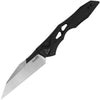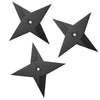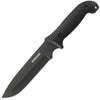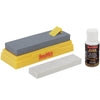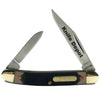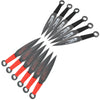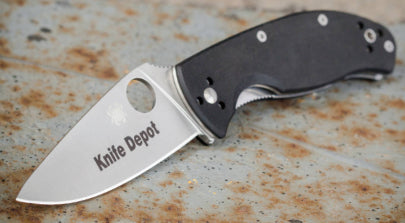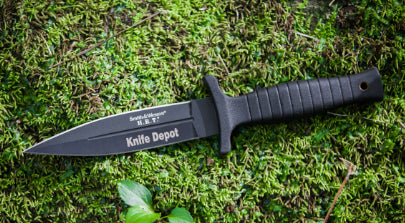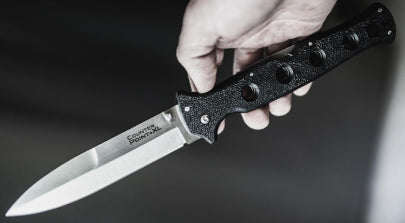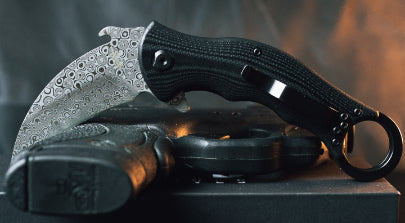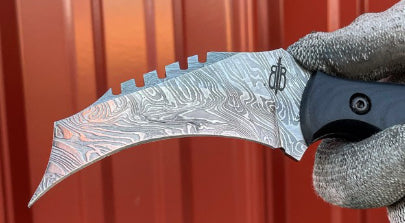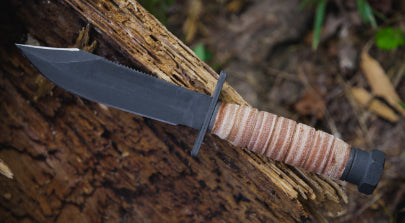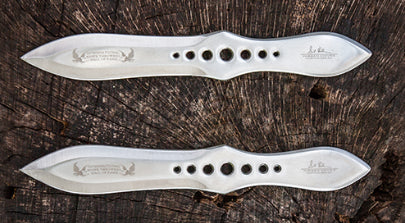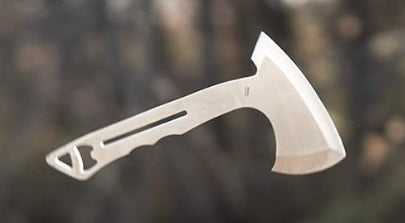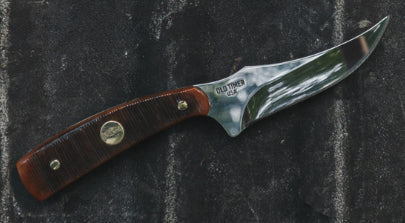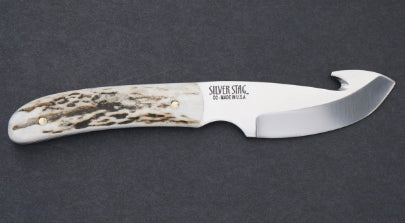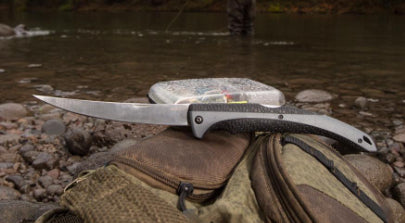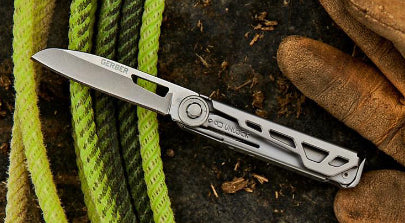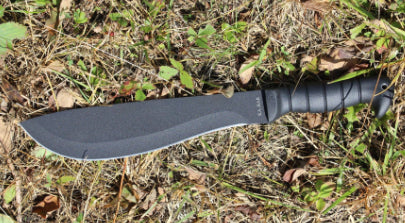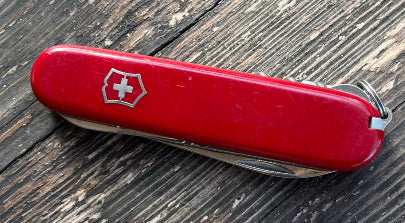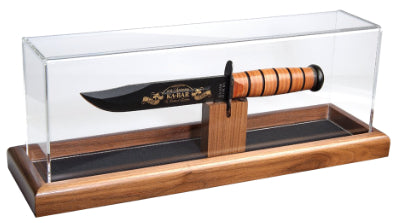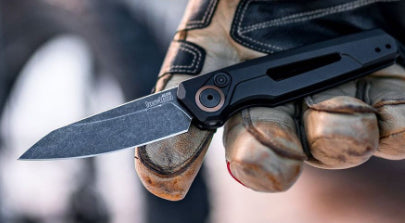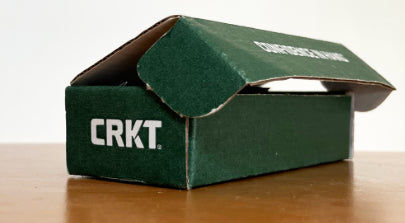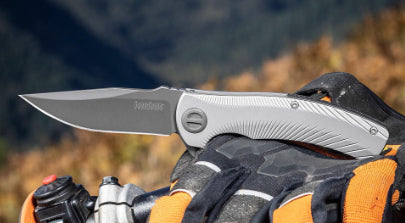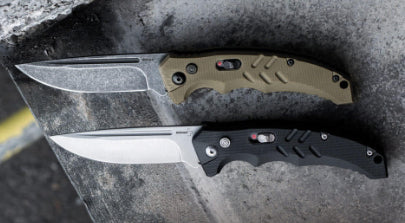Machete Buying Guide
From the old sugar fields of Florida and the subtropical rainforests of South America to the mountainous regions of Nepal and the grasslands of West Africa, the machete is one of the most widely used tools in the world.

No matter where you go, you'll see machetes being utilized in every way imaginable, from harvesting bananas in Jamaica to opening coconuts in Ghana. In some of the less desirable locales, machetes are even brandished in a threatening manner.
So what makes the machete such a compelling tool? We'll explore that in our guide, discuss some of the different variations, and give a few recommendations on our favorite machetes.
- Section 1: Background of the Machete
- Section 2: Types of Machetes
- Section 3: Common Machete Features
- Section 4: Popular Machete Brands
- Section 5: Knife Depot's Machete Recommendations
Background of the Machete


Despite the machete's widespread use, no clear origin story of the tool exists. Since it's probable many similar designs were developed concurrently, there's also no instance of the first machete being created like the Bowie knife. Instead, the machete likely evolved from several designs.
What we do know for sure is that the machete has been around since at least the 16th century. In the mid-1700s when Great Britain invaded Cuba, peasants defended the city with machetes. The reality is that machetes were likely used long before then.
Origin of the design
Many knife historians agree that the original concept of the machete was likely inspired by the falchion, with some cues taken from the billhook.
The falchion was a popular medieval short sword prominently used in the 13th century. This one-handed sword has European origins and was enjoyed for its versatility. It was cheaper to make than other swords, so it was mostly considered a weapon for peasants. Like machetes themselves, the designs varied by location, but the falchion typically had a straight blade with a slight curve at the tip and a quilloned crossguard .
The billhook was another piece of the machete puzzle. It is used mostly in agriculture and forestry around the world and has varied designs. It has the look of a meat cleaver with a wood handle, but the blade is curved inward to improve cutting capabilities.
When you remove the crossguard from the versatile falchion and add some of the cutting qualities of the billhook, you get the machete.
How it got its name
Because the genesis is a bit murky, it's hard to pinpoint exactly how the tool became prominently known as the machete. Machete is combination of the Spanish word macho and the suffix -ete. Macho in Spanish means manly or brave, but it can also be a variation of mazo (which is a sledgehammer or mallet). The suffix is a diminutive, meaning a small sledgehammer.
According to a few sources like the Online Etymology Dictionary, the word dates back to the 1590s, but that information should be taken with a grain of salt.
Common machete uses

The machete is legendary as an all-purpose tool around the world. Here are some of the reasons people use machetes.
Agricultural: The machete is renowned for its superb cutting abilities, making it a natural tool for agriculture. It can be and has been used for harvesting crops, including corn, sugar cane, buckwheat, oats, millet, and more.
Clearing brush: Wildfires are a huge threat to many homes and wildlife refuges, and dry brush is a major factor in their spread. Machetes play an important role in keeping fire-prone areas free from dry brush because they quickly and efficiently slice through the dead vegetation.
Creating and maintaining paths: When vegetation attempts to reclaim an established path, few things are better at clearing out overgrown plants and vines than a machete. The reasons are simple: they're generally inexpensive and easy to wield.
Camping: From chopping up firewood to building shelter, the machete is a popular tool while camping.
Food preparation: Believe it or not, the machete is frequently used throughout the world in all stages of food preparation. Machetes are used to butcher and prepare game, split open coconuts, harvest grapes, and chop up vegetables.
Self-defense: Since the machete is such a common tool, it has often been used for self-defense and as a sidearm throughout history. We'll explore this area of the machete in the next section.
The machete's role in history
As much as the tool has been used to empower workers to accomplish everyday tasks, the machete has also played both a noble and adversarial role in history.

Since the machete is a common tool in third-world countries, it's often featured heavily in violent uprisings, genocidal massacres, and dictatorial crackdowns. The machete was used by militants during the Rwandan genocide and is still used by soldiers in the Boricua Popular Army (who are also known as macheteros).
Still, for all the infamy the machete has accumulated, equal amounts of bravery and mythology have been attributed to the machete's legendary status.
When Great Britain invaded Cuba in the 1760s, peasant guerrillas brandished machetes to fight against invading forces. Although Havana fell, the machete became an iconic weapon that represented the struggle against hegemony.
The machete is also prominently featured on the national flag of Angola as a symbol of peasantry and the armed struggles needed to gain independence.
Types of Machetes
As you learned from the previous section, machetes are used in countless capacities across the world. Its widespread use has bred a number of variations for individual tasks and regional necessities. Although there are only minor differences between some of the variations, here is a breakdown of the most common types of machetes.

Kukri Machete

Description: The kukri (also known as the khukuri) is native to Nepal and its neighboring countries but has quickly become popular in the United States. The design of the kukri can vary quite a bit, but it generally has a 16-inch or so highly curved blade that's optimized for chopping. The tipped point is made for piercing and puncturing while the thin area near the handle can be used for whittling.
Uses: The Nepalese people use the kukri as an everyday utility tool. Its uniquely shaped blade is surprisingly versatile. As discussed above, it excels at chopping, but it can also be used for whittling, cutting food, skinning animals, building, and more. Still, the most well-known use of the kukri is for military and self-defense purposes.
Examples:
Bolo Machete

Description: The bolo is the Filipino version of the machete that's since spread to Indonesia, Cuba, and the United States. Its basic design includes a long blade made for chopping. While that's the general design, there are many variations within the bolo machete category, which is why bolo machetes come in all types of shapes. A few of the bolo types are the haras, garab, sundang, and others.
Uses: It's most commonly used as a farming implement, but because the blade is optimized for chopping, it's also a great camping tool. In certain countries, you'll see the bolo being used to open coconuts.
Examples:
Parang

Description: Another Southeast Asian machete, the parang differs in that the blade can get up to 24 inches in length. Parangs have the look of a long sword with a wide end to prevent it from slipping out of the hand. Because the blades tend to be so long, they typically feature three edges.
Uses: The top edge is designed for skinning, the middle for chopping, and the bottom for whittling. It's used mainly in the jungles or as a tool for furniture-making.
Examples:
Golok

Description: The Golok is of Indonesian descent and is sometimes used interchangeably with the parang in Malaysia. These tend to be shorter and heavier than parangs, however. The golok is a symbol of masculinity in certain cultures in Indonesia.
Uses: Whereas parangs are meant for vegetation, goloks are meant more for chopping heavier brush and branches. You'll also see the golok used in self-defense.
Examples:
Barong

Description: The blade of the barong is reminiscent of a wide leaf. These heavy knives are more swords than machetes in the Philippines. Barongs vary in size, but they tend to be fairly long.
Uses: Barongs are mostly used in combat or Filipino martial arts. However, they also serve some of the same purposes as other types of machetes. You can use them to clear brush and cleave vines.
Examples:
Panga

Description: The panga is an African variation of the tool. It's similar to the bolo, except the upswept portion of the blade near the tip is usually sharpened to a point. Pangas tend to be heftier with a deep belly and slight curve.
Uses: Like the bolo, the panga is great at slicing and chopping moderately thick pieces of wood and vegetation. The major difference is the upswept point, which gives it excellent piercing capabilities.
Examples:
- Cold Steel Panga Machete
- Cold Steel Panga Machete with Polypropylene Handle
- United Cutlery Colombian Panga Machete
Traditional Machete

Description: We're putting this under the category of "traditional" machete, but this type is also called a latin machete, bush machete, or Collins machete (after one of the first manufacturers of machetes). This is a traditional machete that you probably envision when you hear the term. It usually has a long blade with little or no curve until the very tip of the blade. The blade may also broaden toward the tip gradually.
Uses: This type of machete doesn't have a specialty and is considered an all-purpose tool. These are evenly weighted and can come in different blade lengths. They slide easily into sheaths and can accomplish most outdoor tasks.
Example:
Tapanga Machete

Description: The distinguishing feature of the tapanga machete is its blunt blade. Like the panga, the tapanga is popular in Africa and the Caribbean. It has a slightly backswept chisel-like tip that shouldn't be used for prying. Tapangas often have three line grooves in the blade to help give it better chopping balance.
Uses: The blade is front-weighted for chopping all types of things, including woody stalks and brush.
Examples:
Heavy Machete and Cane Machete

Description: The heavy machete is the true workhorse of the group. It has fantastic chopping power thanks to its large blade. The blade usually has a straight back with a curved blade that abruptly ends without a tip. A cane machete, on the other hand, is the same thing except it has a small hook at the reverse tip of the blade. Because the differences are so minor, we're including them together.
Uses: Since it's weighted toward the blade, the heavy or cane machete is the ultimate chopping tool, perfect for nearly anything you encounter. The heavy blade can also be used for light prying. On cane machetes, the hook is there to pick up cut cane.
Examples:
- Cold Steel Heavy Machete
- Tramontina Cane Machete
Bowie Machete

Description: This is a newer addition to the field with solid American origins. A mix between the classic Bowie knife and the machete, a Bowie machete is essentially a longer version of the Bowie — at least 10 inches or longer.
Uses: These are intended to be more versatile with its clip-point blade and superb chopping capabilities. Bowie machetes make excellent campsite tools.
Examples:
Common Features of Machetes
Now that you know some of the machete categories, here are features you'll frequently encounter on the different variations.
Sawback

Certain machetes will have teeth on the unsharpened backside of the blade. How far it extends down the blade will depend on the manufacturer, but its main purpose is for sawing through tough vegetation. The teeth can also be used to pull branches out of your way or drag away brush.
Some complain that the sawback has more limitations than benefits, but it's completely a matter of preference.
Examples:
- Gerber Gator Machete
- Ontario Knife Traditional Sawback Machete
- Apocalypse Combat Machete
Lanyard hole

Those who don't know much about machetes might wonder why you need a lanyard hole since it's too heavy to attach to your keys. The real reason for a lanyard hole is extra security. The idea behind the lanyard on a machete is to wrap it around your wrist, so it doesn't fly out of your hand when you're swinging it.
Again, this is a matter of preference. Some highly value the extra security it provides (and even debate the best way to wrap it around the wrist) while others will never use it. You'll want to think about it before buying a machete.
Examples:
Hook

The hook on the machete was really pioneered by Woodman's Pal, since it's featured on most of the company's machetes. (You'll now also see it on other machetes like the Gerber Gator, however.) The hook has a sharpened inside that makes slicing through tough vines and branches a breeze. It can also be used to grab and pull brush if needed.
Examples:
Front and/or rear quillon

Like the lanyard hole, the quillons are a method to provide extra security to the grip while wielding a machete. A quillon is the protrusion between the blade and handle of a knife designed to keep the hand from sliding onto the blade. Rear quillons are also popular on knives like machetes because they keep the hand from slipping off the back end.
Examples:
Knuckleguard

The knuckleguard is yet another method for keeping the machete firmly in your hand, but it is probably more useful protecting the hand against an adversary. The knuckleguard may also be used to protect the hand against branches.
While the knuckleguard does serve its purpose, many feel it limits the versatility of the machete because it can only be held a few ways.
Examples:
- United Cutlery Columbia Sawback Machete
- Ontario Knife Company Field Machete
- Woodman's Pal Premium Plus Machete
Two-handed handle

While some people put the two-handed machete into its own category, two-handed machetes come in all sorts of styles. The main purpose of the longer handle is twofold; a longer handle allows for an extended reach and better leverage when swinging.
These tend to be specialty machetes for very specific tasks, so be aware of what you need the machete for before buying.
Examples:
Fuller

Also known as blood grooves, the fuller is a groove near the spine of a blade that's designed to reduce the weight of the blade. It lightens the blade by displacing the steel. Fullers, which can be side by side, are particularly popular on kukris.
In lieu of a fuller, sometimes a machete has cut-outs in the blade to reduce the weight.
Examples:
Popular Machete Brands
If you're browsing across the web for a new machete, chances are you're seeing the same names over and over. Here's more information about the most common machete brands you'll encounter.
Condor Tool & Knife

When it comes to machetes, you'd be remiss not to seriously consider something from Condor Tool & Knife. With roots that trace way back to 1787, the company specializes in tools like machetes, axes, shovels, and knives. Imacasa is the parent company of Condor Tool & Knife (the North American and European brand) and has operations in Central America, which is why there's no surprise it's one of the largest machete manufacturers in the world.
A few of the Condor Tool & Knife machetes are the Bushcraft Parang and Warlock Machete.
Cold Steel

Say what you will about Cold Steel products but the company has a strong commitment to bringing some of the most innovative machetes available. Cold Steel dabbles in pretty much all styles of machetes, including everything from the barong machete to the heavy machete. They even pioneered the Bowie machete. If you want something new or unique, Cold Steel is a good place to look.
Gerber

Gerber is still relatively new to the machete market, so its offerings aren't as robust as someone like Condor Tool & Knife; nevertheless, Gerber machetes are extremely popular. Several variations of Gerber Gator machetes allow you to pick the size and style you desire while the Bear Grylls parang machetes are interesting additions.
Tramontina

Even though we don't carry Tramontina products here at Knife Depot, it'd be irresponsible to omit the company. Tramontina is a Brazilian company that was founded in 1911. Here in the United States, Tramontina is mainly a cookware and cutlery company, but you'll frequently come across machetes from Tramontina in other parts of the world.
KA-BAR

Most well-known for its iconic combat/utility knife, KA-BAR has made a strong run in recent years at producing a variety of quality knives. Like Gerber, there's still not too much to choose from, but what it does have available is more than worthy of serious consideration. The Kukri Machete and Grass Machete are real workhorses, but the Becker Machax and the Johnson Adventure Parangatang are truly one-of-a-kind.
Knife Depot's Machete Recommendations
Instead of just giving you everything you need to know about machetes, we understand some of you may prefer recommendations. These are some of our favorite machetes.
Schrade Bolo Machete

The Schrade Bolo Machete is a remarkable outdoor tool. Its curvaceous 7.3-inch blade is made from 3Cr13 stainless steel that's coated in titanium nitride to improve edge retention and corrosion resistance. Normally, bolo machetes are mainly meant for farming and chopping vegetation, but the blade shape on this one makes it more versatile.
The deep handle grip prevents the tool from flying out of the hand when batoning wood or clearing brush. What makes this machete from Schrade even more prepared for survival situations is the nylon sheath with fire-starter and sharpening stone.
KA-BAR Kukri Machete

Modeled after the Nepalese kukris, this Kukri Machete from KA-BAR is a chopping machine. Its deeply curving blade provides a nice belly that tears through brush and vegetation. The 11.5-inch blade is made from 1085 carbon steel with matte black coating to reduce its reflectivity.
The handle is surprisingly comfortable too. Not only is the Kraton handle highly durable but the protruding pommel also adds an extra sense of security and control.
Woodman's Pal Military Premium Machete

Woodman's Pal machetes get extra marks for being original, American-made, and extremely well-made. The Woodman's Pal Military Premium Machete is the company's best-known model. Featuring the distinctive sickle hook, the machete can tear through tough vines with impunity. The more than 10-inch blade is made from high carbon stainless steel and has a flexible design to prevent breakage in different weather conditions.
Balancing out the machete is a soft leather handle that feels natural in the hand. A steel knuckleguard keeps the hand protected. You'll understand why this is such a respected machete the moment it's in your hand.
Condor Tool & Knife Golok Machete

We wanted to add some variety to our recommendations, so we included the Golok Machete from Condor Tool & Knife. Whether you're clearing a trail or setting up a campsite, the machete feels like an extension of the arm as it swings through the air as smooth as silk.
The 1075 high carbon steel blade is 14 inches long and curves upward near the tip. The good-looking walnut handle curves toward the pommel to keep it from sliding out of your hand. You'll instantly enjoy the unique look and natural feel of this machete.
Cold Steel 24-inch Latin Machete

For the camper on a budget, the Cold Steel Latin Machete is the perfect option. This inexpensive tool embraces the simplicity of the traditional machete without sacrificing functionality. The 24-inch 1055 carbon steel blade is perfect for clearing out brush and cutting low-hanging branches.
Its polypropylene handle is comfortable in the hand, which is essential when swinging about this long machete. While nothing spectacular, this budget-friendly machete will get the job done.











